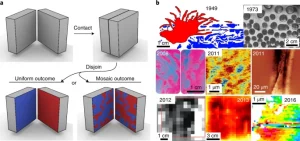Article by Prof. Bartosz Grzybowski in Nature Physics
For the longest time, it was assumed that two contacting/sliding materials are charging oppositely and uniformly. In the 1940s though it was observed that each of the separated surfaces is carrying both, (+) and (-) charges, after CE. The creation of so-called charge mosaics was attributed to the irreproducibility of experiments, inherent inhomogeneities of contacting materials, or a general “stochastic nature” of CE. The group of Prof. Grzybowski shows that these charge mosaics are a direct consequence of electrostatic discharges. The experiments demonstrate that between delaminating materials the sequences of “sparks” are created and they are responsible for forming the (+/-) charge distributions that are symmetrical on both materials. The proposed theory explains why charge mosaics were seen on many different materials, including sheets of paper, rubbing balloons, steel balls rolling on Teflon surfaces, or polymers detached from the same or other polymers. It also hints at the origin of crackling noise when you peel off a sticky tape – it might be a manifestation of the plasma discharges plucking the tape like a guitar string. Presented research should help control the potentially harmful electrostatic discharges and bring us closer to true understanding of the nature of contact electrification.

Y. I. Sobolev, W. Adamkiewicz, M. Siek, B. A. Grzybowski, “Charge mosaics on contact-electrified dielectrics result from polarity-inverting discharges”, Nature Physics
Congratulations and we wish you continued success!